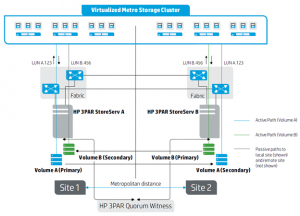
3PAR StoreServ Peer Persistence and vSphere Metro Storage Cluster
What is vSphere Metro Storage Cluster?
vSphere Metro Storage Cluster is a certified configuration for stretched storage cluster architectures. A vMSC configuration is designed to maintain data availability beyond a single physical or logical site. A storage device configured in the vMSC configuration is supported after successful vMSC certification. All supported storage devices are listed in the VMware Storage Compatibility Guide.
What is HP 3PAR Peer Persistence?
HP 3PAR Peer Persistence is an extension of HP 3PAR Remote Copy software and HP 3PAR OS that enables a pair of HP 3PAR StoreServ Storage systems, located at metropolitan distances, to act as peers to each other and present a nearly continuous storage system to hosts connected to them. Volumes presented to hosts are replicated across the pair of arrays and kept in sync. Each pair of replicated and synchronized volumes across each array share the same WWN and appear as the same volume to the hosts. Taking advantage of Asymmetric Logical Unit Access (ALUA) capabilities that allow paths to a SCSI device to be marked as having different characteristics, hosts connect to volumes on one array via active paths, and connect to replicated volumes on the other array via standby paths. ALUA Path status and host availability to the volumes are controlled by Peer Persistence software. This capability allows customers to configure a high-availability solution between two sites or data centers where switchover and switchback of access to the volumes across arrays remains transparent to the hosts and applications running on those hosts.
HP 3PAR Quorum Witness
The HP 3PAR Quorum Witness is a component provisioned as a virtual machine that is typically deployed at a third site. The HP 3PAR Quorum Witness, along with the two HP 3PAR StoreServ Storage systems, forms a three part quorum system. This quorum system allows monitoring of the status of both the HP 3PAR StoreServ Storage systems and the storage site inter-links. A number of site and inter-link failure scenarios can be recognized by this three part quorum system, and appropriate failover actions implemented. In the event of a disaster that may bring either one of the storage systems or sites down, and in conjunction with Peer Persistence software, a failover to the surviving StoreServ system is automatically initiated. During this failover operation, replicated volumes on the remaining storage system are made active. The host paths to those volumes are also made active, thereby ensuring that hosts can continue to access their volumes without any disruption or outage. Communication between the three sites for quorum is via the Quorum Witness IP and the service management IP’s of the two HP 3PAR StoreServ Storage systems. HP 3PAR Quorum Witness does not actively participate in data storage and a failure or removal of the HP 3PAR Quorum Witness from an otherwise functioning environment will have no impact. The HP 3PAR Quorum Witness only comes into play when one site or the ISL has failed or if two quorum members have failed simultaneously.
Configuration Requirements
These requirements must be satisfied to support a vMSC configuration with HP 3PAR.
- VMware vSphere 5 Metro Storage Cluster configured for uniform host access per VMware requirements and best practices.
- HP 3PAR StoreServ Storage arrays configured for Peer Persistence with Automated Transparent Failover per HP documentation and best practices.
- HP 3PAR Quorum Witness and VMware vCenter deployed at a third site.
- vSphere vCenter Server connected to ESXi hosts in both data centers
- Maximum round trip latency on the storage network between sites should not exceed 2.6ms RTT.
- FC-switched SAN for host-array connectivity and array inter-link connectivity.
- Any IP subnet used by the virtual machine must be accessible by all ESXi hosts in all data centers within the Metro Storage Cluster.
Solution Overview
A tested and certified VMware Metro Storage Cluster using HP 3PAR StoreServ Storage is supported in accordance with the VMware description of a “uniform access” vMSC configuration. Particular to the uniform access configuration, host data path connections at each site are cross-connected to the peer data center site storage array. ESXi hosts access volumes in the data center local array via active paths. Connectivity to standby peer volumes on the distance array are maintained in standby mode until such time as a failover or switchover. In concert with HP 3PAR Peer Persistence, Quorum Witness and with Automated Transparent Failover (ATF) enabled, a minimally disruptive switchover or failover of volume access across sites can be achieved.
For example, in case of an array failure on one site (site 1):
1.Loss of quorum is detected by the Quorum Witness and the surviving storage array at site 2.
2.Peer Persistence software on array at site 2 makes the peer volumes and the cross-connected paths from the hosts on site 1 to the array on site 2, active.
3.Site 1 hosts, virtual machines, and applications access peer volumes on site 2 and continue normal operation.
The failover is automated with Peer Persistence and ATF, but transparent failback after fault correction is a manual process.
This diagram depicts a high level overview:

